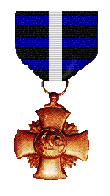 |
Amphibian Tractor Battalion |
 |
Amphibian Tractor Battalion |
| *Cochran, Robert F., Jr. | 18 August 1965 | ||
| *Lauer, Charles R. | 18 June 1967 | ||
| *Lumbard, Donald W. | 4 July 1966 | ||
| *Peczeli, Joseph S. | 24 March 1967 | ||
| Ralya, Warren H., Jr. | 20 January 1968 | ||
| *Roberson, James J. | 24 March 1967 | ||
| Soliz, Thomas | 6 September 1967 | ||
| *Yates, John Charles | 17 October 1968 | ||
| The Navy Cross was established on February 4, 1919 with the passage of Public Law 193 by the 65th Congress of the United States. Until then there was but one medal, the Medal of Honor, also known as the Congressional Medal of Honor because it is awarded in the name of Congress.
Established in 1861 the Medal of Honor was awarded "for gallantry in action and other seaman-like (soldier-like) qualities." With this broad criteria, two thousand six hundred twenty-five Medals of Honor were awarded between 1862 and 1916 when a permanent Medal of Honor Board was established as part of a sweeping review of the entire awards and decorations procedures of the military. Nine hundred ten awards of the Medal of Honor were recalled(eight hundred sixty-four of those recalled had been awarded to members of one regiment, the 27th Maine, by President Lincoln as inducement to continue guarding the capitol past the approaching end of their enlistment). No awards to Navy personnel were, or have since been, recalled. It had become clear during the First World War that one medal alone could not effectively recognize the full range of exceptional service, including heroism. So the criteria of the Medal of Honor was elevated to be awarded to: "one who shall in action with an enemy, distinguish himself conspicuously by gallantry and intrepidity at the risk of his life above and beyond the call of duty." Stringent requirements for documentation were imposed, and new awards were created in a descending order of precedence. The Navy Cross came into existence at this time along with the Navy Distinguished Service Medal, the Army Distinguished Service Cross and Service Medal, and the Silver Star Certificates (later to become the Silver Star Medals). These were the framework of a graduated system of recognition which did not exist before. From their inception, distinction between the Navy Cross (originally intended for combat bravery only) and the Navy Distinguished Service Medal, became blurred. For many years the Navy Cross was ranked third in order of precedence below the Medal of Honor and Navy Distinguished Service Medal. With the passage of Public Law 702 on August 7, 1942 the issue was resolved. This act clarified the criteria which now states that the award of the Navy Cross shall be to "any person while serving in any capacity with the Navy or Marine Corps who distinguishes himself with extraordinary heroism not justifying the award of the Medal of Honor — (1)while engaged in an action against an enemy of the United States; (2)while engaged in military operations involving conflict with an opposing foreign force; or (3)while serving with friendly foreign forces engaged in an armed conflict against an opposing armed force in which the United States is not a belligerent party. To warrant this distinctive decoration the act should involve risk of life so extraordinary as to set the person apart from his contemporaries. An accumulation of minor acts of heroism does not justify the award." Congress also specified that the Navy Cross was to rank (along with the Army Distinguished Service Cross and now the Air Force Cross)as the second highest honor the nation can bestow for combat heroism The Navy Cross, made of bronze, was designed by James Earle Fraser. It is a broad-faced cross patee with the ends of the arms rounded. The cross is one and one-half inches wide with a circle in the middle of the cross encompassing the design of a sailing vessel. Laurel leaves are represented at each joining of the arms about the center. In the center of the circle on the reverse side of the medal are crossed anchors and the letters "USN." The Navy Cross has not been numbered nor has it usually been engraved with the name of the recipient. The medal is suspended by a thin half inch ring from a one and three-quarter inch wide ribbon of navy blue moire silk with a quarter inch wide white center stripe. Through World War II the metal used was a dark bronze. Since then the cross has been made of a lighter, brighter colored metal. |
The precedence of Navy decorations is as follows: |
| Medal of Honor | |
| Navy Cross | |
| Defense Distinguished Service Medal* | |
| Distinguished Service Medal | |
| Silver Star Medal | |
| Defense Superior-Service Medal* | |
| Legion of Merit | |
| Distinguished Flying Cross | |
| Navy and Marine Corps Medal | |
| Bronze Star Medal | |
| Purple Heart | |
| Defense Meritorious Service Medal* | |
| Meritorious Service Medal | |
| Air Medal | |
| Joint Service Commendation Medal* | |
| Navy Commendation Medal | |
| Joint Serive Achievement Medal* | |
| Navy Achievement Medal | |
| Combat Action Ribbon | |
| *Not a Navy medal but authorized if awarded by name and earned in joint service action. |